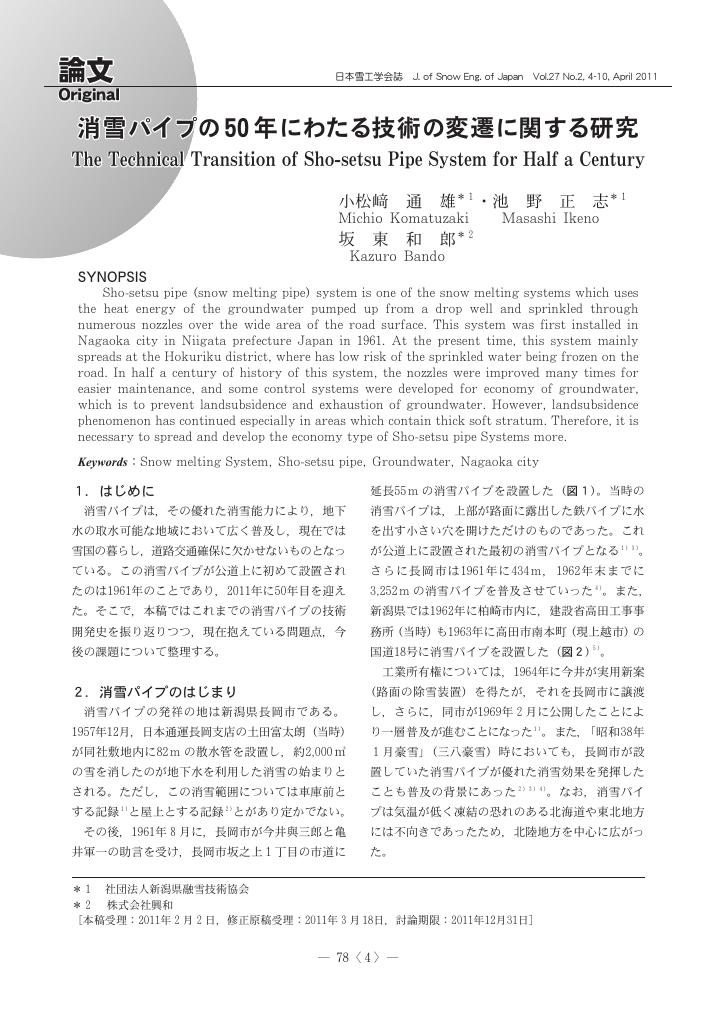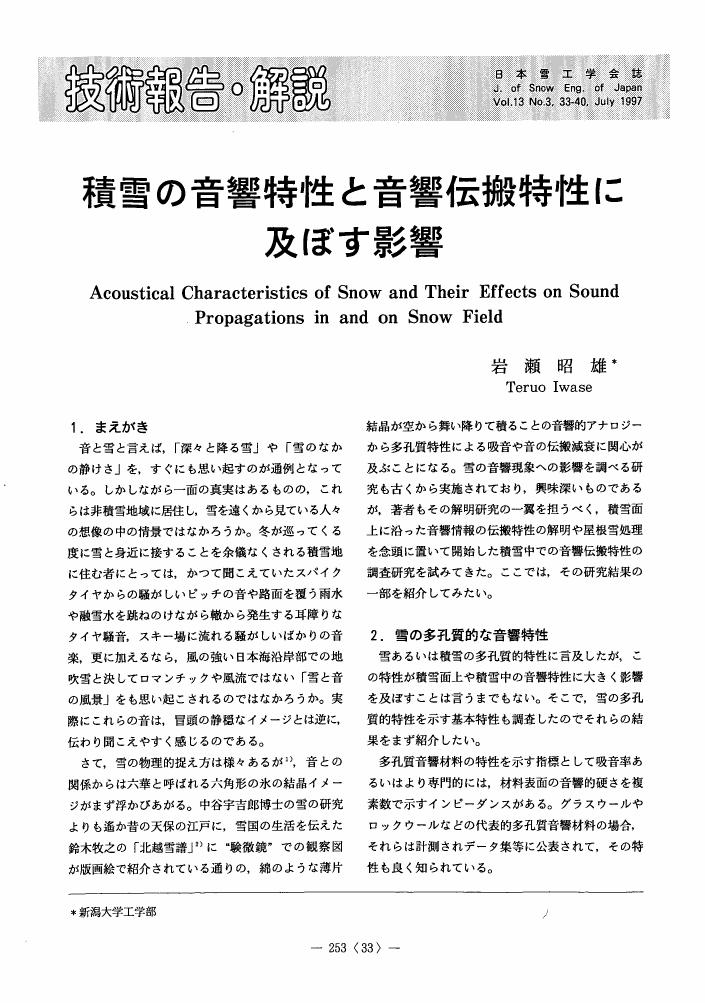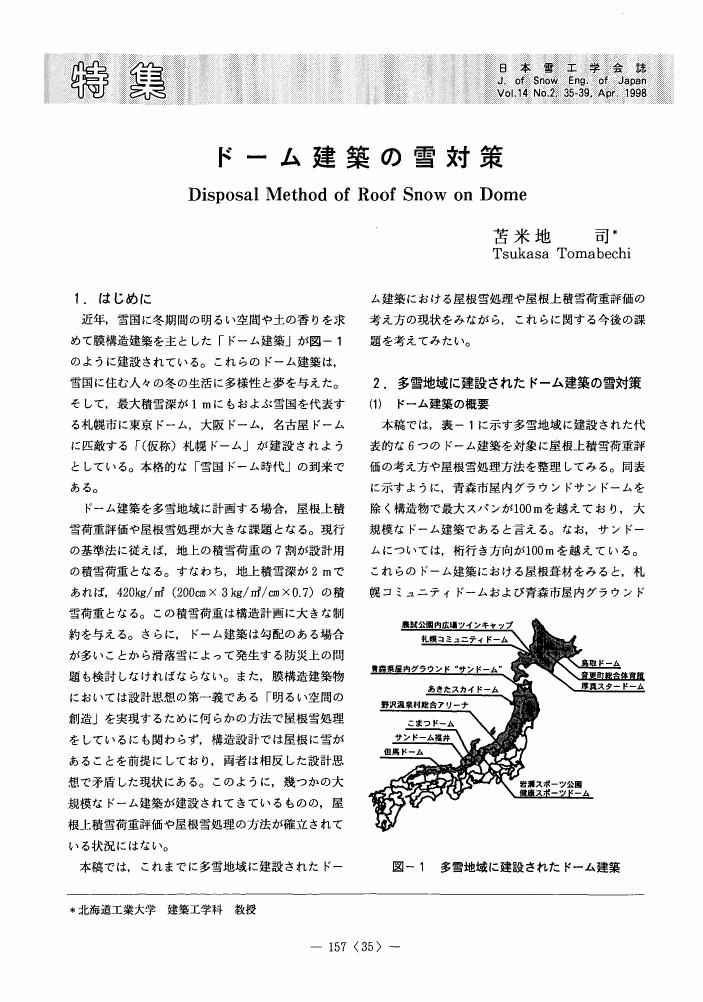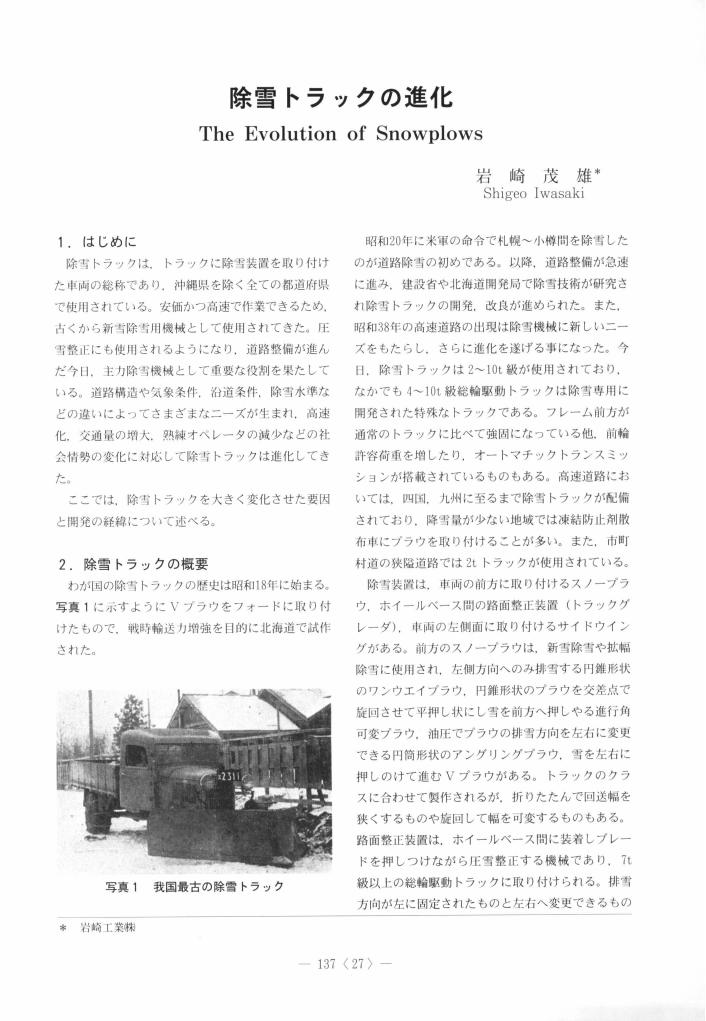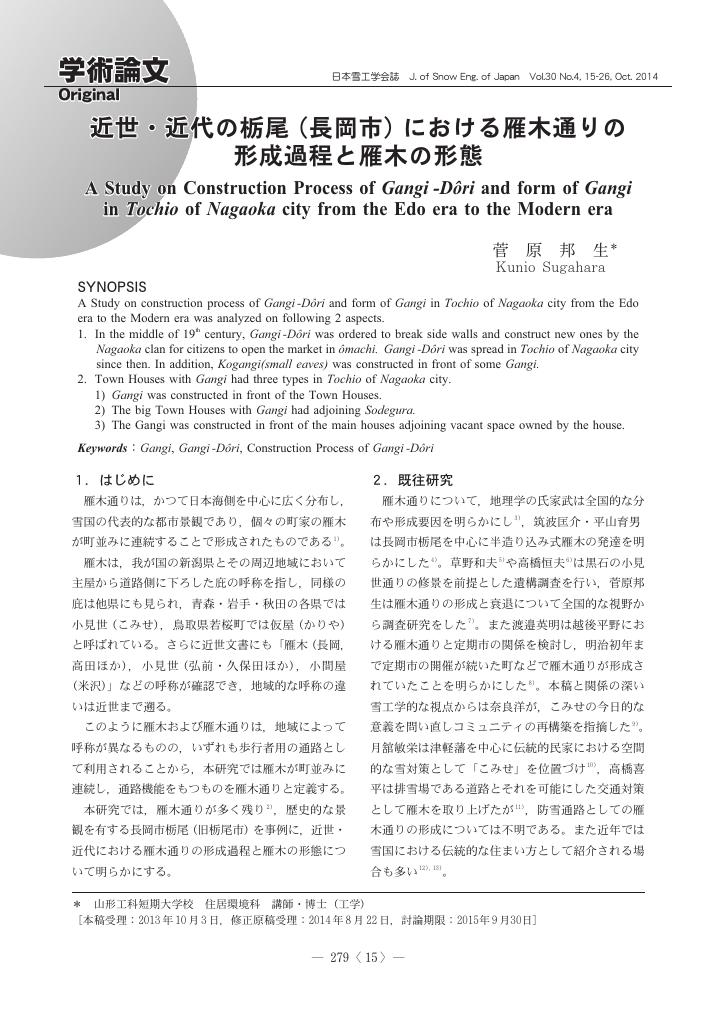54 0 0 0 OA 消雪パイプの50年にわたる技術の変遷に関する研究
- 出版者
- 日本雪工学会
- 雑誌
- 日本雪工学会誌 (ISSN:09133526)
- 巻号頁・発行日
- vol.27, no.2, pp.78-84, 2011 (Released:2018-10-05)
- 被引用文献数
- 2 1
10 0 0 0 OA 高速道路の雪氷対策の現状と課題
- 著者
- 村國 誠
- 出版者
- 日本雪工学会
- 雑誌
- 日本雪工学会誌 (ISSN:09133526)
- 巻号頁・発行日
- vol.11, no.4, pp.303-309, 1995-10-01 (Released:2009-05-29)
6 0 0 0 OA 積雪の音響特性と音響伝搬特性に及ぼす影響
- 著者
- 岩瀬 昭雄
- 出版者
- Japan Society for Snow Engineering
- 雑誌
- 日本雪工学会誌 (ISSN:09133526)
- 巻号頁・発行日
- vol.13, no.3, pp.253-260, 1997-07-01 (Released:2009-05-29)
- 参考文献数
- 12
4 0 0 0 OA セッションA 雪崩
- 出版者
- 日本雪工学会
- 雑誌
- 日本雪工学会誌 (ISSN:09133526)
- 巻号頁・発行日
- vol.20, no.5, pp.1-18, 2004-11-01 (Released:2009-05-29)
- 著者
- 月舘 敏栄
- 出版者
- 日本雪工学会
- 雑誌
- 日本雪工学会誌 (ISSN:09133526)
- 巻号頁・発行日
- vol.15, no.2, pp.140-143, 1999
2 0 0 0 OA ドーム建築の雪対策
- 著者
- 苫米地 司
- 出版者
- Japan Society for Snow Engineering
- 雑誌
- 日本雪工学会誌 (ISSN:09133526)
- 巻号頁・発行日
- vol.14, no.2, pp.157-161, 1998-04-01 (Released:2009-05-29)
- 参考文献数
- 6
2 0 0 0 OA 遠赤外線の融雪効果
- 著者
- 田名瀬 寛之 和泉 聡 立川 弘
- 出版者
- Japan Society for Snow Engineering
- 雑誌
- 日本雪工学会誌 (ISSN:09133526)
- 巻号頁・発行日
- vol.17, no.1, pp.49-53, 2001-01-01 (Released:2009-05-29)
- 参考文献数
- 1
2 0 0 0 セッションK 建築物の雪処理
- 出版者
- Japan Society for Snow Engineering
- 雑誌
- 日本雪工学会誌 (ISSN:09133526)
- 巻号頁・発行日
- vol.20, no.5, pp.187-204, 2004
2 0 0 0 セッションK 雪と地域産業
- 出版者
- Japan Society for Snow Engineering
- 雑誌
- 日本雪工学会誌 (ISSN:09133526)
- 巻号頁・発行日
- vol.15, no.4, pp.103-114, 1999
1 0 0 0 OA 膜屋根の落雪制御『あきたスカイドームの間欠融雪運転法』
- 著者
- 早川 真 佐倉 勇
- 出版者
- Japan Society for Snow Engineering
- 雑誌
- 日本雪工学会誌 (ISSN:09133526)
- 巻号頁・発行日
- vol.12, no.3, pp.234-238, 1996-07-01 (Released:2009-05-29)
- 参考文献数
- 2
- 被引用文献数
- 1 1
- 出版者
- 日本雪工学会
- 雑誌
- 日本雪工学会誌 (ISSN:09133526)
- 巻号頁・発行日
- vol.27, no.3, pp.204-213, 2011 (Released:2018-10-05)
- 被引用文献数
- 1 1
1 0 0 0 OA 屋内人工スキー場の雪制御
- 著者
- 二階堂 稔
- 出版者
- Japan Society for Snow Engineering
- 雑誌
- 日本雪工学会誌 (ISSN:09133526)
- 巻号頁・発行日
- vol.15, no.2, pp.117-120, 1999-04-01 (Released:2009-05-29)
- 参考文献数
- 4
1 0 0 0 OA 新潟県の最深積雪について
- 著者
- 田村 伸夫
- 出版者
- Japan Society for Snow Engineering
- 雑誌
- 日本雪工学会誌 (ISSN:09133526)
- 巻号頁・発行日
- vol.4, no.1, pp.3-24, 1988-03-01 (Released:2009-05-29)
- 参考文献数
- 28
The purpose of this paper is to explain the distinctive features of the maximum snow depths in NIIGATA prefecture. The maximum snow depth data for the 'cold half' years from 1891 to 1987 were collected from the NIIGATA Local Meteorogical Observatory. The number of observatories keeping data is 60.Concluding remarks are as follows :(1) The deepest disturibution of maximum snow depth is determined by the difference in the height of the eastside or southside mountain chains. (Figs.1, 2, 3, 4)(2) The shallowest disturibution of maximum snow depth is closely proportional to the height of each observatory. (Figs.1, 5)(3) The heavy snow's patterns in NIIGATA prefecture are classified into two types : 1945 yr. and 1963yr. (Figs.6, 7, 8, 9)(4) The upper limit of maximum snow depth which is estimated relative to an observatoty's height is shown by the following formula. (The upper limit line is designated "N-Line", Fig.10)Hs=200 logH+75Hs : the upper limit of maximum snow depth (cm)H : the height of the observatory (m)However, the maximum snow depths of two observatories, TAKADA and TOCHIOMATA, were over the N-Line.(5) Taking into account the changes in the maximum snow depths after the latter term of the Meiji era, there seems to be two cycles of snowfalls : a cycle where there is a relatively little snowfall followed by a period of heavy snowfall and then repeating. (Fig.11)(6) In the UONUMA area which has a heavy snowfall for NIIGATA prefecture, there are cycles of mild winters from 5-8 years. All mild winters are not the same as in El Nino years, but there is a possibility that a big El Nino brings a mild to average winter (relatively mild snowfall) to the UONUMA area. (Fig. 12)
1 0 0 0 OA 雪害 1996
- 出版者
- Japan Society for Snow Engineering
- 雑誌
- 日本雪工学会誌 (ISSN:09133526)
- 巻号頁・発行日
- vol.12, no.4, pp.294-312, 1996-10-01 (Released:2009-05-29)
1 0 0 0 OA 除雪トラックの進化
- 著者
- 岩崎 茂雄
- 出版者
- Japan Society for Snow Engineering
- 雑誌
- 日本雪工学会誌 (ISSN:09133526)
- 巻号頁・発行日
- vol.18, no.2, pp.137-141, 2002-04-01 (Released:2009-05-29)
- 参考文献数
- 8
1 0 0 0 OA 瓦葺き屋根に設置した太陽電池アレイ上の雪処理
- 著者
- 東山 禎夫 向瀬 慎一 浅野 和俊
- 出版者
- Japan Society for Snow Engineering
- 雑誌
- 日本雪工学会誌 (ISSN:09133526)
- 巻号頁・発行日
- vol.14, no.1, pp.16-25, 1998-01-01 (Released:2009-05-29)
- 参考文献数
- 9
A removal method of snow accumulated on a photovoltaic (PV) array installed at a pantiled roof was examined using a model house in 1994/1995 winter season. The photovoltaic array with a rate of 1kW consists of ten PV panels and each panel was individually heated by injecting do current from a dc power supply. The roof surface around the array was covered with the electrically-heated roof tiles. When snow slides down from the panels and the temperature at the under surface of the panel rises to 3 degrees, the heating circuit automatically turns off and the system for generating electric power turns on. Snow on the photovoltaic array and the pantiled roof usually slides down within 3 to 4 hours after heating. The snow sliding system works effectively in assistance of sunshine. After snow sliding, the photovoltaic array can generate electricity in a sunny day, although the gained energy is less than whole energy to snow removal. Since the generated power is considerably reduced owing to the existence of a little snow lump on the array, snow should be removed clearly.
1 0 0 0 OA 北海道における新築住宅の仕様と室内環境
- 著者
- 長谷川 寿夫
- 出版者
- Japan Society for Snow Engineering
- 雑誌
- 日本雪工学会誌 (ISSN:09133526)
- 巻号頁・発行日
- vol.20, no.2, pp.158-161, 2004-04-01 (Released:2009-05-29)
- 参考文献数
- 1
1 0 0 0 OA 雪・氷の利用
- 著者
- 石沢 賢二
- 出版者
- Japan Society for Snow Engineering
- 雑誌
- 日本雪工学会誌 (ISSN:09133526)
- 巻号頁・発行日
- vol.17, no.4, pp.349-351, 2001-10-01 (Released:2009-05-29)
1 0 0 0 OA マイクロ波の積雪中の伝搬特性
1 0 0 0 OA 近世・近代の栃尾(長岡市)における雁木通りの形成過程と雁木の形態
- 著者
- 菅原 邦生
- 出版者
- 日本雪工学会
- 雑誌
- 日本雪工学会誌 (ISSN:09133526)
- 巻号頁・発行日
- vol.30, no.4, pp.279-290, 2013 (Released:2018-12-21)
